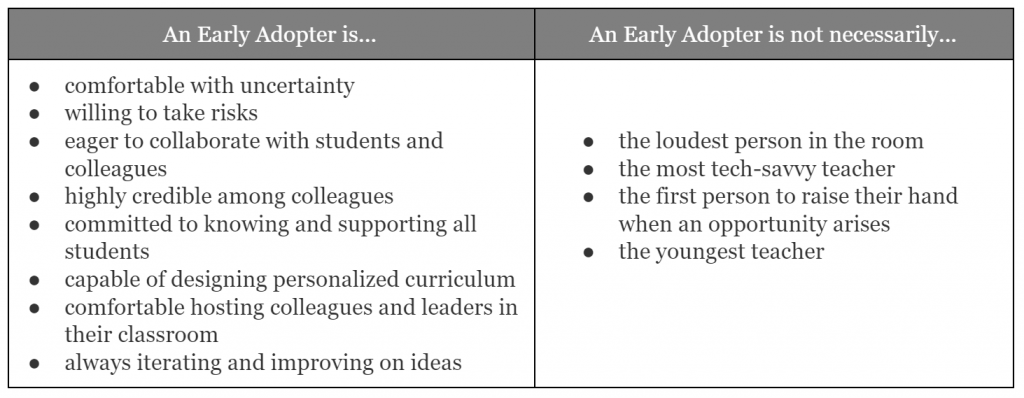The key to successful change initiatives? Early adopter teachers
August 22, 2018 |
August 22, 2018 |
 It is 5pm on a Tuesday in April, and Liz has just dropped her daughter off at cheer practice. Instead of heading home to think about dinner, chatting with other moms, or checking her social media accounts, Liz spends the next 95 minutes in a nearby Starbucks completing three playlists for her engineering design class. A science teacher at a high school that recently prioritized student choice as a core instructional strategy, Liz is creating a new unit for her STEM class. She has assembled resources, essential questions, and a design process to allow her students to explore either bridge construction, alternative energy, or robotics. Students will then propose a final project aligned with their interest in one of these fields. Needless to say, building this new unit has taken a lot of time.
It is 5pm on a Tuesday in April, and Liz has just dropped her daughter off at cheer practice. Instead of heading home to think about dinner, chatting with other moms, or checking her social media accounts, Liz spends the next 95 minutes in a nearby Starbucks completing three playlists for her engineering design class. A science teacher at a high school that recently prioritized student choice as a core instructional strategy, Liz is creating a new unit for her STEM class. She has assembled resources, essential questions, and a design process to allow her students to explore either bridge construction, alternative energy, or robotics. Students will then propose a final project aligned with their interest in one of these fields. Needless to say, building this new unit has taken a lot of time.
Liz is most definitely what we at the Highlander Institute would consider an “early adopter” teacher. Over the past five years we have observed, supported, and collaborated with close to 500 teachers and administrators from more than 40 districts who are interested in pursuing more personalized approaches to learning. We wholeheartedly believe that early adopter teachers are well positioned to be the engine of any personalized-learning initiative. So what do we mean by “early adopter teachers”?
The adoption curve
The concept of an early adopter is attached to the diffusion of innovation theory, popularized by noted sociologist and communications expert Everett Rogers as a way of defining how innovations are adopted by groups of individuals. Essentially, the theory classifies individuals into one of five adoption categories: innovators (risk takers), early adopters (visionaries), early majority (pragmatists), late majority (conservatives), and laggards (skeptics). The implementation of personalized-learning approaches tends to follow a similar curve, with adoption of new models and practices often relying on teachers in various categories influencing and guiding adoption for the next group.

Source: Adapted from Everett Rogers, Diffusion of Innovations (London and New York: Free Press, 1962)
We believe excellent teachers can be found throughout the diffusion of the innovation curve and are not suggesting early adopter teachers are “best.” However, just as technology startups count on early adopters in the marketplace to determine the relevance of new products, administrators can count on early adopter teachers to identify the value and wider application of promising blended- and personalized-learning practices. These entrepreneurial teachers are best positioned to wrestle with the uncertainties of instructional shifts and fail forward. Empowering early adopter teachers to explore new concepts, strategies, and models protects the larger faculty from the frustration and stress that can accompany trailblazing redesign. Lessons learned from early adopter teachers can be baked into implementation pathways to ease adoption for teachers farther down the curve.
How to identify early adopters
Identifying early adopters is one way to use the transition period to new innovations to elevate teaching. Early adopter teachers typically represent approximately 13 percent of teaching faculty, and identifying early adopter teachers is one of the most important tasks of school and district leaders. While this process may seem obvious, we have seen leaders mis-identify teachers who do not really have the persistence and mindset for change possessed by true early adopters. Without exception, early adopter teachers have mastered foundational classroom skills, including the demonstrated ability to create a strong, respectful culture and effective routines. The table below provides additional guidance to support accurate identification.

At the Highlander Institute, early adopter teachers are the bedrock of our change management framework which is explored in depth in Pathways to Personalization: A Framework for School Change. Co-authored with my colleague Shawn C. Rubin, the book offers guidance on how savvy administrators can identify and empower early adopters to define and model their aspirational instructional shifts. This approach challenges the existing narrative around education change management, where leaders identify a single solution or model, require all teachers to implement the reform together, and invest significant time in coaxing reluctant teachers to participate. “When I started this work, I was consumed with figuring out how to get resistant teachers to participate in reform efforts and ensure 100% implementation rates,” reflected Robert Mitchell, Superintendent of the Cumberland School District in Cumberland, RI, at a recent design meeting. “I realize now that investing in early adopter teachers is a much more constructive use of resources with an exponentially higher return on investment.”
Early adopters as teacher leaders
Empowering early adopter teachers helps administrators understand what is possible, what approaches are easiest to implement in different classrooms, and what strategies are most aligned to district strengths and needs. Early adopter teachers can be tasked with operationalizing a vision, determining the promise of new policies or tools, launching a professional learning community, or collecting and sharing resources to support a school or district initiative. In Liz’s classroom, the excitement generated by her new unit encouraged her colleagues to explore the playlist structure that she developed, and demonstrated how teachers could operationalize the district priority of giving students more choice. Her experience also enabled her colleagues to avoid the initial challenges she faced, easing their process of trying something new.
As the summer marches closer to September, how might your school or district leverage early adopter teachers to actively support your vision for teaching and learning?
For more information on defining and identifying early adopter teachers, check out the Blended Learning Teacher Competency Framework from iNACOL (October 2014) and Educator Competencies for Personalized, Learner-Centered Teaching from Jobs for the Future and the Council of Chief State School Officers (August 2015).
For in-the-field examples, learn from some of our educator and school partners featured on the Blended Learning Universe (BLU).
Cathy Sanford leads research and development efforts at the Highlander Institute in Providence, RI. She supports several initiatives across the institute’s portfolio, including Fuse RI, the forthcoming book Pathways to Personalization: Framework for School Change, and the annual Blended & Personalized Learning Conference (in partnership with The Learning Accelerator). Share your thoughts and insights with Cathy by tweeting @csanford42.
Leave a Reply